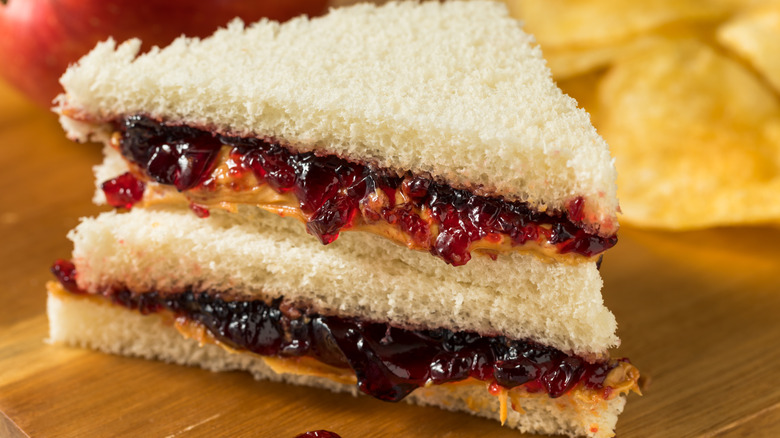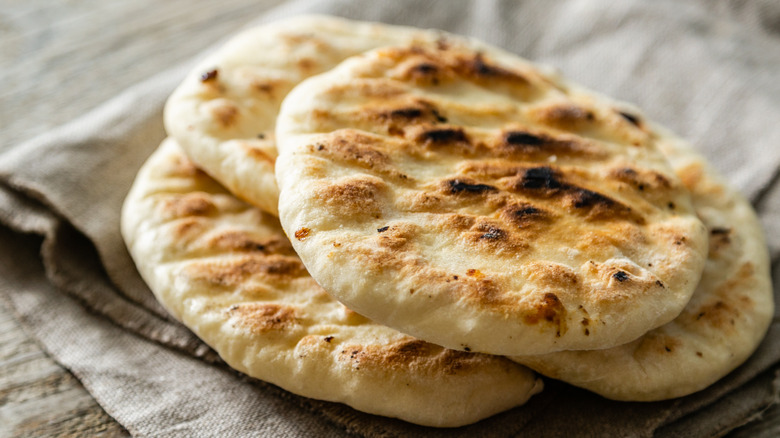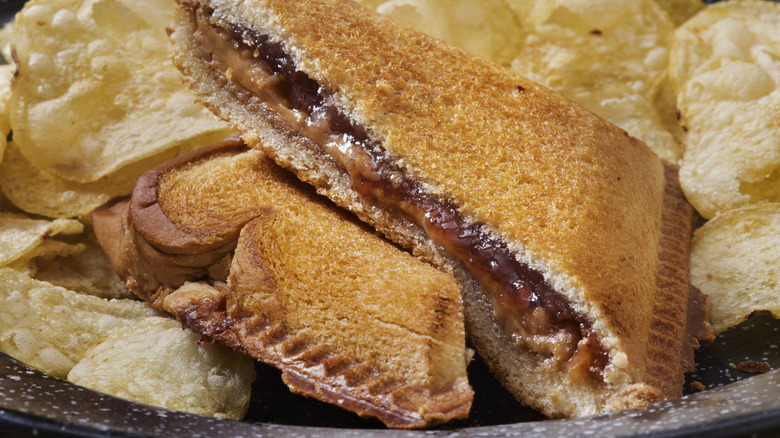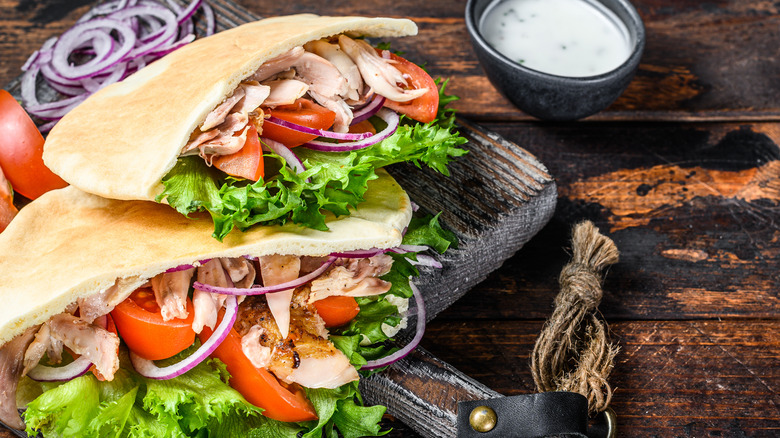Pita Bread Is Your Secret Weapon For No-Crust PB&J
We may be divided as a nation regarding SKIPPY or Jif peanut butter, but we can all agree that a PB&J sandwich is delicious at any age. It's a crustless favorite for school-aged kids and what Ina Garten prepares for lunch dates with our beloved Jeffrey. Garten uses toasted Pepperidge Farms white bread, SKIPPY creamy peanut butter, and raspberry jam from Eli Zabar (the splurge in an otherwise simple sandwich) and keeps the crust on.
If your little kid at home refuses to eat the bread's crust, instead of cutting off the perimeter or, worse, stamping out a pattern with an oversized cookie cutter (losing a quarter of the sandwich), swap the traditional white bread for naturally crustless pita to make your next peanut butter and jelly. Unlike traditional sandwich bread, which can get soggy from the jelly over time, pita holds up to wet ingredients longer, like when stuffed with a gyro's juicy meat and drizzled with tzatziki sauce.
Its heartier texture can handle thick dips like hummus and baba ghannouj, so the homemade version of Smucker's Uncrustables is no match (full disclosure — they're on team Jif). As an underused carb in this part of the world, it's time we used pitas for more than just falafel. It's the solution to all our no-crust sandwiches.
Homemade Uncrustables
To make a pita PB&J, trim a 1 ½ inch section from the top of the pita to expose its pocket (keeping that piece as a snack for yourself) and smear the inside with your preferred peanut butter and jelly.
Pita is a commercially leavened flatbread most commonly identified by its airy pocket, although there are versions used for Greek souvlaki without one. The sturdy but soft bread is a staple in Mediterranean and Middle Eastern cuisines, also known as "Arabic bread" and "pocket bread."
Its high-hydration, wet dough is traditionally baked at high temperatures over an open flame or in a stone oven causing its steam to inflate the dough's inside, creating its signature pocket. Modern recipes cook the dough in a conventional oven or stovetop in a piping hot cast-iron pan, similar to tortillas.
Pita is drier but similar to Naan, another popular flatbread, and both make suitable substitutions when used as edible utensils for dips and curries. Unlike naan, pita is also commonly stuffed or used as a sandwich wrap.
Easier toasted PB&J sandwiches
Pita bread is an excellent choice if you prefer your PB&J sandwich warm or toasted. You can either toast the bread in the traditional way beforehand, or spread a few tablespoons of your favorite peanut butter and jelly inside the pocket, and then pop the sandwich upright into a toaster. The result is a crustless, warm, and gooey sandwich that's irresistible.
The pita pocket keeps the ingredients intact, and prevents them from leaking out as they warm up. If you have a toaster oven, you can also prepare the sandwich open-faced, like a PB&J pizza, without worrying about the jelly seeping through the bread. Using pita bread allows you to experiment with additional fillings, adding texture while ensuring they don't slide out when you take a bite. Consider adding sliced bananas, strawberries, shredded coconut, or bacon to the pita pocket to find your new favorite combination. Or, for a spicy twist, mix canned chipotle peppers into your peanut butter and jelly for a memorable kick.
Additional ways to enjoy pita bread
Aside from apparently being an acronym on Urban Dictionary for "Pain In The A$$," pita can instantly upgrade other lunch options. Since the pocket sandwich keeps ingredients from falling out the bottom, use it for all your favorite grilled cheese sandwiches. Fill it with classic American cheese or try the salty/sweet combination of fig jam, goat cheese, and crispy bacon. And yes, it's as good as it sounds.
Pitas also make a great individual pizza base when you keep it whole. Top the bread with traditional sauce and mozzarella cheese, or make eggs in a nest pizza for breakfast.
The bread also makes lunch salads more satisfying when you eat them with torn pita instead of a fork. If you need something more portable, fill the pita with your favorite salad, and don't worry about the dressing making the bread soggy. Simply take the section of pita you trimmed off, flip it, and insert it on the bottom of the pocket, where liquids will pool. The extra layer of pita prevents the dressing from causing the sandwich to leak out the bottom. This game-changing technique lets you fill a pita with anything, even Thanksgiving leftovers complete with gravy and cranberry sauce. The possibilities are endless!




